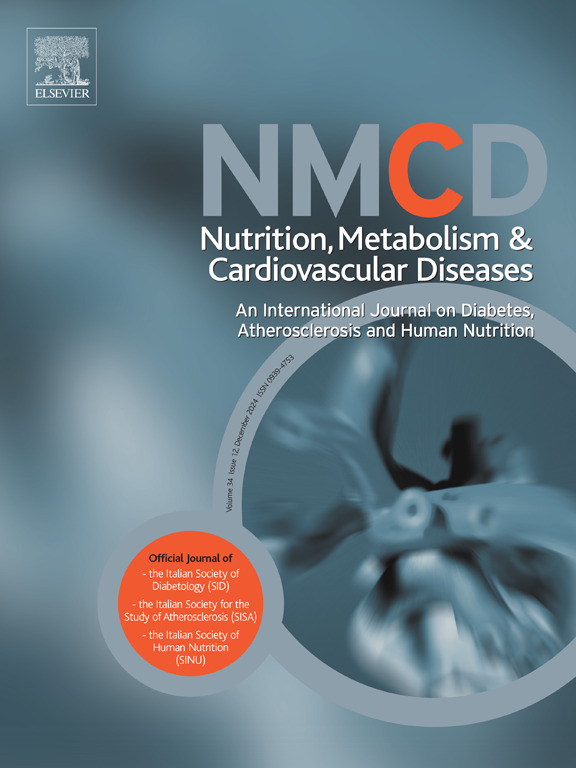代谢综合征与心血管-肾脏-代谢健康:评估系统性硬化症患者死亡率的预测风险因素。
IF 3.3
3区 医学
Q2 CARDIAC & CARDIOVASCULAR SYSTEMS
Nutrition Metabolism and Cardiovascular Diseases
Pub Date : 2025-03-01
DOI:10.1016/j.numecd.2025.103968
引用次数: 0
摘要
背景和目的:很少有研究涉及系统性硬化症(SSc)患者的MetS。人们提出了几种分类来定义代谢综合征(MetS)。该研究的目的是评估代谢代谢和心血管肾脏代谢健康评估是否可以预测SSc患者在10年随访期间的死亡率。方法与结果:连续入组90例SSc患者。根据国家胆固醇教育计划成人治疗小组III (NCEP/ATP-III)、NCEP- r、国际糖尿病联合会(IDF)和心血管-肾-代谢综合征(CKM)分类标准进行met诊断。21例(23.3%)SSc患者死亡。Kaplan-Meier曲线显示,根据NCEP-ATPIII, met患者的总生存概率较短(p)。结论:MetS是SSc患者全因死亡率的危险因素,但与基础疾病无关。本文章由计算机程序翻译,如有差异,请以英文原文为准。
Metabolic syndrome and cardiovascular-kidney-metabolic health: Evaluation of predictive risk factor for mortality in systemic sclerosis
Background and aims
Few studies have addressed the MetS in systemic sclerosis (SSc) patients. Several classifications have been proposed to define metabolic syndrome (MetS). The aim of the study was to evaluate if MetS and cardiovascular-kidney-metabolic health assessment may predict mortality in SSc patients during a 10-year follow-up.
Methods and results
Ninety consecutive SSc patients were enrolled. The diagnosis of MetS was made according to the criteria of the National Cholesterol Education Program Adult Treatment Panel III (NCEP/ATP-III), NCEP-R, International Diabetes Federation (IDF) and cardiovascular-kidney-metabolic syndrome (CKM) classification. Mortality was observed in 21 (23.3 %) SSc patients. Kaplan-Meier curves showed that overall survival probability was shorter in patients with MetS according to NCEP-ATPIII (p < 0.001), NCEP-R (p < 0.05) and IDF (p < 0.05) compared to patients without MetS; while the overall survival was similar in patients with CKM 0–1 and patients with CKM 2-3-4. Cumulative incidence rate of SSc-related death was similar in patients with MetS according to NCEP-ATPIII, NCEP-R and IDF compared to patients without MetS and in patients with CKM 0–1 and patients with CKM 2-3-4. Cumulative incidence rate for all-cause mortality not-SSc related was higher in patients with MetS according to NCEP-ATPIII (p < 0.001), NCEP-R (p < 0.01) and IDF (p < 0.01) compared to patients without MetS; while the cumulative incidence rate all-cause mortality not-SSc related was similar in patients with CKM 0–1 and patients with CKM 2-3-4.
Conclusions
MetS is a risk factor for all-cause mortality in SSc patients but not related to underlying disease.
求助全文
通过发布文献求助,成功后即可免费获取论文全文。
去求助
来源期刊
CiteScore
6.80
自引率
2.60%
发文量
332
审稿时长
57 days
期刊介绍:
Nutrition, Metabolism & Cardiovascular Diseases is a forum designed to focus on the powerful interplay between nutritional and metabolic alterations, and cardiovascular disorders. It aims to be a highly qualified tool to help refine strategies against the nutrition-related epidemics of metabolic and cardiovascular diseases. By presenting original clinical and experimental findings, it introduces readers and authors into a rapidly developing area of clinical and preventive medicine, including also vascular biology. Of particular concern are the origins, the mechanisms and the means to prevent and control diabetes, atherosclerosis, hypertension, and other nutrition-related diseases.

 求助内容:
求助内容: 应助结果提醒方式:
应助结果提醒方式:


